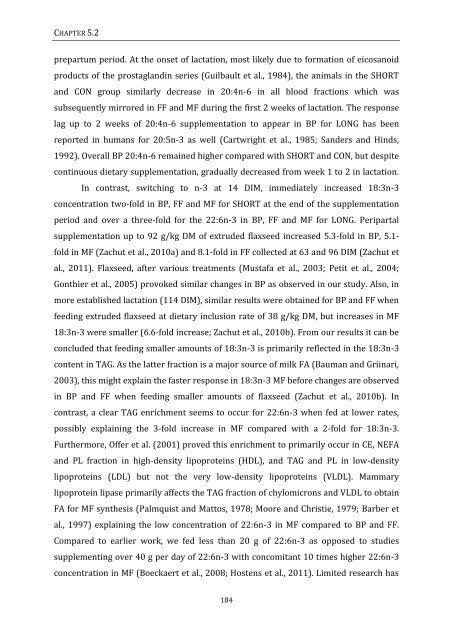view - Department of Reproduction, Obstetrics and Herd Health
view - Department of Reproduction, Obstetrics and Herd Health
view - Department of Reproduction, Obstetrics and Herd Health
You also want an ePaper? Increase the reach of your titles
YUMPU automatically turns print PDFs into web optimized ePapers that Google loves.
CHAPTER 5.2<br />
prepartum period. At the onset <strong>of</strong> lactation, most likely due to formation <strong>of</strong> eicosanoid<br />
products <strong>of</strong> the prostagl<strong>and</strong>in series (Guilbault et al., 1984), the animals in the SHORT<br />
<strong>and</strong> CON group similarly decrease in 20:4n-6 in all blood fractions which was<br />
subsequently mirrored in FF <strong>and</strong> MF during the first 2 weeks <strong>of</strong> lactation. The response<br />
lag up to 2 weeks <strong>of</strong> 20:4n-6 supplementation to appear in BP for LONG has been<br />
reported in humans for 20:5n-3 as well (Cartwright et al., 1985; S<strong>and</strong>ers <strong>and</strong> Hinds,<br />
1992). Overall BP 20:4n-6 remained higher compared with SHORT <strong>and</strong> CON, but despite<br />
continuous dietary supplementation, gradually decreased from week 1 to 2 in lactation.<br />
In contrast, switching to n-3 at 14 DIM, immediately increased 18:3n-3<br />
concentration two-fold in BP, FF <strong>and</strong> MF for SHORT at the end <strong>of</strong> the supplementation<br />
period <strong>and</strong> over a three-fold for the 22:6n-3 in BP, FF <strong>and</strong> MF for LONG. Peripartal<br />
supplementation up to 92 g/kg DM <strong>of</strong> extruded flaxseed increased 5.3-fold in BP, 5.1-<br />
fold in MF (Zachut et al., 2010a) <strong>and</strong> 8.1-fold in FF collected at 63 <strong>and</strong> 96 DIM (Zachut et<br />
al., 2011). Flaxseed, after various treatments (Mustafa et al., 2003; Petit et al., 2004;<br />
Gonthier et al., 2005) provoked similar changes in BP as observed in our study. Also, in<br />
more established lactation (114 DIM), similar results were obtained for BP <strong>and</strong> FF when<br />
feeding extruded flaxseed at dietary inclusion rate <strong>of</strong> 38 g/kg DM, but increases in MF<br />
18:3n-3 were smaller (6.6-fold increase; Zachut et al., 2010b). From our results it can be<br />
concluded that feeding smaller amounts <strong>of</strong> 18:3n-3 is primarily reflected in the 18:3n-3<br />
content in TAG. As the latter fraction is a major source <strong>of</strong> milk FA (Bauman <strong>and</strong> Griinari,<br />
2003), this might explain the faster response in 18:3n-3 MF before changes are observed<br />
in BP <strong>and</strong> FF when feeding smaller amounts <strong>of</strong> flaxseed (Zachut et al., 2010b). In<br />
contrast, a clear TAG enrichment seems to occur for 22:6n-3 when fed at lower rates,<br />
possibly explaining the 3-fold increase in MF compared with a 2-fold for 18:3n-3.<br />
Furthermore, Offer et al. (2001) proved this enrichment to primarily occur in CE, NEFA<br />
<strong>and</strong> PL fraction in high-density lipoproteins (HDL), <strong>and</strong> TAG <strong>and</strong> PL in low-density<br />
lipoproteins (LDL) but not the very low-density lipoproteins (VLDL). Mammary<br />
lipoprotein lipase primarily affects the TAG fraction <strong>of</strong> chylomicrons <strong>and</strong> VLDL to obtain<br />
FA for MF synthesis (Palmquist <strong>and</strong> Mattos, 1978; Moore <strong>and</strong> Christie, 1979; Barber et<br />
al., 1997) explaining the low concentration <strong>of</strong> 22:6n-3 in MF compared to BP <strong>and</strong> FF.<br />
Compared to earlier work, we fed less than 20 g <strong>of</strong> 22:6n-3 as opposed to studies<br />
supplementing over 40 g per day <strong>of</strong> 22:6n-3 with concomitant 10 times higher 22:6n-3<br />
concentration in MF (Boeckaert et al., 2008; Hostens et al., 2011). Limited research has<br />
184









